Tissue inhibitor of metalloproteinase 1 activates normal human granulocytes, protects them from apoptosis, and blocks their transmigration during inflammation
- PMID: 14688084
- PMCID: PMC343974
- DOI: 10.1128/IAI.72.1.82-88.2004
Tissue inhibitor of metalloproteinase 1 activates normal human granulocytes, protects them from apoptosis, and blocks their transmigration during inflammation
Abstract
Urinary levels of tissue inhibitor of metalloproteinase 1 (TIMP-1) higher than those of matrix metalloproteinase 9 (MMP-9) during acute pyelonephritis have previously been associated with a higher degree of acute inflammation and of postinfective renal scarring. The aim of the present study was to evaluate possible mechanisms by which TIMP-1 could affect the scarring process already during the acute phase of inflammation. The growth of Escherichia coli, bactericidal activity of fresh human blood, and respiratory burst, spontaneous apoptosis, and trans-basement membrane migration of normal human granulocytes were studied in vitro in the presence of different concentrations of recombinant human TIMP-1. To imitate the "normal" environment during inflammation in the kidney, granulocytes were also incubated with a conditioned medium from E. coli-stimulated renal epithelial cells. In order to compare our data with the in vivo situation, blood and urinary leukocyte levels were analyzed for 40 children with acute pyelonephritis, together with urinary MMP-9 and TIMP-1 levels. TIMP-1 at a concentration of 500 ng/ml increased the bactericidal activity of blood, increased the respiratory burst of granulocytes, decreased phosphatidylserine exposure and caspase 3 activity, which are features of spontaneous apoptosis, and inhibited granulocyte transmigration. Moreover, in the patients with pyelonephritis, MMP-9/TIMP-1 ratios in urine correlated with the degree of leukocyte transmigration. Thus, our data suggest that TIMP-1 specifically blocks the transmigration of granulocytes into urine. Entrapped and activated granulocytes, protected from apoptosis, might excessively destroy renal parenchyma and thus contribute to the pathogenesis of renal scarring following acute pyelonephritis.
Figures
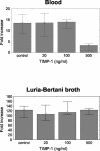
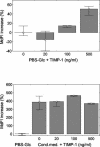
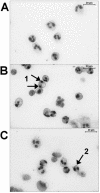
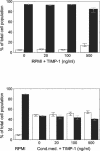


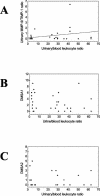
Similar articles
-
Matrix metalloproteinase-9 and tissue inhibitor of metalloproteinases-1 in acute pyelonephritis and renal scarring.Pediatr Res. 2003 Apr;53(4):698-705. doi: 10.1203/01.PDR.0000057575.86337.CB. Epub 2003 Feb 20. Pediatr Res. 2003. PMID: 12612199
-
[Matrix metalloproteinases 2 and 9 and their tissue inhibitors 1 and 2 in the urine of children with pyelonephritis].Pol Merkur Lekarski. 2009 Jul;27(157):10-3. Pol Merkur Lekarski. 2009. PMID: 19650421 Polish.
-
[Serum and urinary concentration of selected metalloproteinases and their tissue inhibitors in children with vesicoureteral reflux].Pol Merkur Lekarski. 2010 Aug;29(170):88-92. Pol Merkur Lekarski. 2010. PMID: 20842819 Polish.
-
TIMP-1 gene expression and PAI-1 antigen after unilateral ureteral obstruction in the adult male rat.Kidney Int. 2000 Sep;58(3):1186-201. doi: 10.1046/j.1523-1755.2000.00274.x. Kidney Int. 2000. PMID: 10972681
-
Relevance of granulocyte apoptosis to resolution of inflammation at the respiratory mucosa.Mucosal Immunol. 2008 Sep;1(5):350-63. doi: 10.1038/mi.2008.31. Epub 2008 Jul 2. Mucosal Immunol. 2008. PMID: 19079199 Free PMC article. Review.
Cited by
-
Identification of Prognostic Biomarkers of Glioblastoma Based on Multidatabase Integration and Its Correlation with Immune-Infiltration Cells.J Oncol. 2022 May 31;2022:3909030. doi: 10.1155/2022/3909030. eCollection 2022. J Oncol. 2022. PMID: 35685428 Free PMC article.
-
Histology-based profile of inflammatory mediators in experimentally induced pulpitis in a rat model: screening for possible biomarkers.Int Endod J. 2021 Aug;54(8):1328-1341. doi: 10.1111/iej.13514. Epub 2021 Mar 31. Int Endod J. 2021. PMID: 33715185 Free PMC article.
-
Glomerular matrix metalloproteinases and their regulators in the pathogenesis of lupus nephritis.Arthritis Res Ther. 2008;10(6):229. doi: 10.1186/ar2532. Epub 2008 Dec 1. Arthritis Res Ther. 2008. PMID: 19090960 Free PMC article. Review.
-
Neurogenic differentiation factor NeuroD confers protection against radiation-induced intestinal injury in mice.Sci Rep. 2016 Jul 20;6:30180. doi: 10.1038/srep30180. Sci Rep. 2016. PMID: 27436572 Free PMC article.
-
Tissue inhibitor of metalloproteinase-1 promotes NIH3T3 fibroblast proliferation by activating p-Akt and cell cycle progression.Mol Cells. 2011 Mar;31(3):225-30. doi: 10.1007/s10059-011-0023-9. Epub 2011 Jan 6. Mol Cells. 2011. PMID: 21350939 Free PMC article.
References
-
- Akgul, C., D. A. Moulding, and S. W. Edwards. 2001. Molecular control of neutrophil apoptosis. FEBS Lett. 487:318-322. - PubMed
-
- Chromek, M., K. Tullus, O. Hertting, G. Jaremko, A. Khalil, Y. H. Li, and A. Brauner. 2003. Matrix metalloproteinase-9 and tissue inhibitor of metalloproteinases-1 in acute pyelonephritis and renal scarring. Pediatr. Res. 53:698-705. - PubMed
-
- Delclaux, C., C. Delacourt, M. P. D'Ortho, V. Boyer, C. Lafuma, and A. Harf. 1996. Role of gelatinase B and elastase in human polymorphonuclear neutrophil migration across basement membrane. Am. J. Respir. Cell Mol. Biol. 14:288-295. - PubMed
Publication types
MeSH terms
Substances
LinkOut - more resources
Full Text Sources
Research Materials
Miscellaneous

